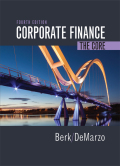
a)
To determine: The project agreed by the equity holder.
Introduction:
Equity is the total value of assets less than the total amount of all liabilities in a company.
Debt is a sum of money borrowed by a person from another. Debt is borrowed by companies and individuals to make a large purchase or to develop business. Debt is an amount that has to be repaid back at a later date, with interest.
b)
To determine: The cost of firm’s debt project
Introduction:
The effective tax rate is the normal tax assessment rate for a
Trending nowThis is a popular solution!

Chapter 16 Solutions
EBK CORPORATE FINANCE
- How do you calculate the intrinsic value of a stock using the dividend discount model (DDM)?arrow_forwardHow does the weighted average cost of capital (WACC) affect a company’s valuation? i need help in this qarrow_forwardHow does the weighted average cost of capital (WACC) affect a company’s valuation?i need correct answer.arrow_forward
- How does the weighted average cost of capital (WACC) affect a company’s valuation?i need help.arrow_forwardHow does the weighted average cost of capital (WACC) affect a company’s valuation? Need helparrow_forwardHow does the weighted average cost of capital (WACC) affect a company’s valuation?arrow_forward
 Essentials Of InvestmentsFinanceISBN:9781260013924Author:Bodie, Zvi, Kane, Alex, MARCUS, Alan J.Publisher:Mcgraw-hill Education,
Essentials Of InvestmentsFinanceISBN:9781260013924Author:Bodie, Zvi, Kane, Alex, MARCUS, Alan J.Publisher:Mcgraw-hill Education,

 Foundations Of FinanceFinanceISBN:9780134897264Author:KEOWN, Arthur J., Martin, John D., PETTY, J. WilliamPublisher:Pearson,
Foundations Of FinanceFinanceISBN:9780134897264Author:KEOWN, Arthur J., Martin, John D., PETTY, J. WilliamPublisher:Pearson, Fundamentals of Financial Management (MindTap Cou...FinanceISBN:9781337395250Author:Eugene F. Brigham, Joel F. HoustonPublisher:Cengage Learning
Fundamentals of Financial Management (MindTap Cou...FinanceISBN:9781337395250Author:Eugene F. Brigham, Joel F. HoustonPublisher:Cengage Learning Corporate Finance (The Mcgraw-hill/Irwin Series i...FinanceISBN:9780077861759Author:Stephen A. Ross Franco Modigliani Professor of Financial Economics Professor, Randolph W Westerfield Robert R. Dockson Deans Chair in Bus. Admin., Jeffrey Jaffe, Bradford D Jordan ProfessorPublisher:McGraw-Hill Education
Corporate Finance (The Mcgraw-hill/Irwin Series i...FinanceISBN:9780077861759Author:Stephen A. Ross Franco Modigliani Professor of Financial Economics Professor, Randolph W Westerfield Robert R. Dockson Deans Chair in Bus. Admin., Jeffrey Jaffe, Bradford D Jordan ProfessorPublisher:McGraw-Hill Education





